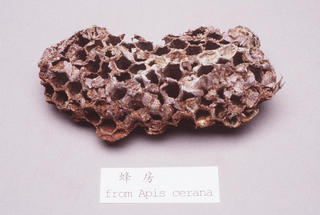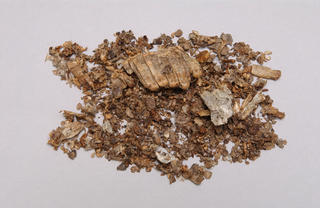Difference between revisions of "Parapolybia varia"
(Created page with "right right == Nomenclature== === Other Names:=== == Historical Use of Parapolybia varia== === Parapolybia varia in Traditiona...") |
(No difference)
|
Latest revision as of 11:28, 21 March 2013
Contents
Nomenclature
Other Names:
Historical Use of Parapolybia varia
Parapolybia varia in Traditional Chinese Medicine
Background
Chinese Name (pinyin): Fengfang
Chinese Name :
Common Name :Honeycomb
Specific Name : Nidus vespae
Scientific Name:
Collection : The drug is collected in autumn and winter, dried in the sun or steam brieflly, removed from dead wasps and pupae and dried in the sun.
Description : In disc-shaped or irregular flattened pieces, some nearly lotus receptacle-shaped, varying in size. The surface greyish white or greyish brown. Ventral side with numerous regular hexagonal openings of cells, the openings 3 - 4mm or 6 - 8mm in diameter, dorsal side with 1 or several black short stalks. Light texture tenacious, slightly elastic, odour slight and taste pungent and weak.. The honeycomb of fragile or hard texture should not be use for medicine.
Identification :
Processing : Eliminate foreign matter, cut into pieces.
Action : To dispel wind, to counteract toxicity, to kill parasites, and to relieve itching.
Indication : toothache due to caries; sores; ulcers; mastitis; scrofula; ringworm, tinea unguium
Precautions :
Dosage : 3 to 5 g, to be decocted or scorched; for external use, appropriate quantity to be ground into powder and applied topically after mixing with oil or to be made into decoction for gargling and washing.
Storage : Preserve in a ventilated dry place, protected from pressure and moth.
Synonymns for Parapolybia varia
Patent Medicines and Medicines with Multiple Ingredients that include Parapolybia varia
Pharmaceutical Information
Chemical Constituents
Evidence or the Use of Parapolybia varia in the Treatment of Epilepesy
Basic Science
Animal Studies
Cohort, Case-Control and Non-Randomized Trials
Randomized Controlled Trials
Meta-Analysis
1st Five Results: pubmed search

